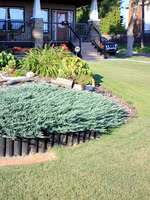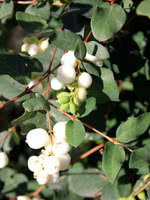Mon-Fri 9am - 5pm Mountain time
Common Snowberry vs Creeping Juniper
Juniperus horizontalis
Symphoricarpos albus
NOT AVAILABLE THIS SEASON - MIGHT RETURN
Creeping Juniper is a low maintenance, spreading, ground cover shrub capable of growing in some of the worst soil and rocky conditions.
You will love this shrubs' pleasant fragrance and year-round color. A beautiful accent or foundation plant, Creeping Juniper has scaly foliage and is commonly used by landscapers to add texture under trees or flower beds. Consider planting Creeping Juniper in areas where grass is difficult to mow or maintain.
Common Snowberry is a small deciduous shrub with characteristic white to pink flowers and clusters of white fruit.
This North American native species is very adaptable, and can be used for erosion control in riparian and restoration areas. Snowberry's fruit attracts wildlife, and livestock can consume the berries without issue.
Creeping Juniper Quick Facts
Common Snowberry Quick Facts
Toxicity: berries toxic to humans

